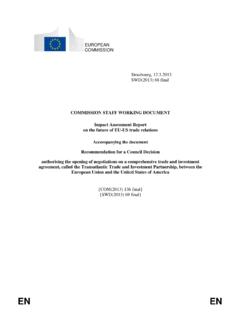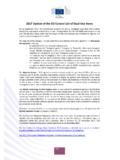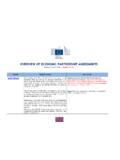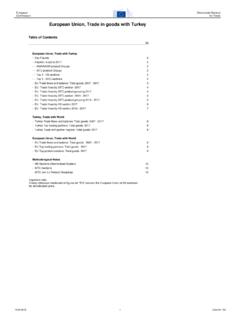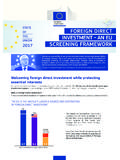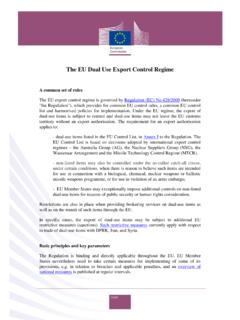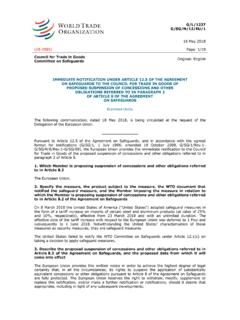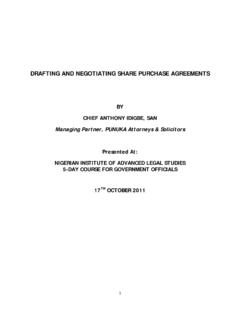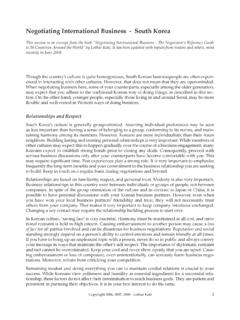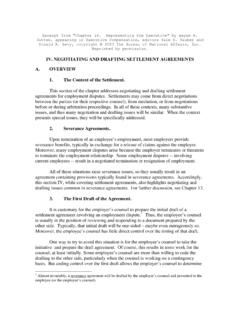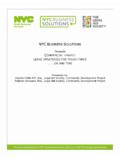Transcription of CETA – Summary of the final negotiating results
1 CETA Summary of the final negotiating results This note summarises the key elements of the Comprehensive Economic and Trade Agreement between the EU and Canada (CETA). The negotiators of the Commission and of Canada finalised their work in early August 2014. The Member States and the European Parliament received the complete text on 5th August ( 259/14). President Barroso, President Van Rompuy and Prime Minister Harper announced the end of the CETA negotiations at the EU-Canada Summit on 26 September 2014.
2 The text of the agreement was made public the same day. On 29 February 2016, the European Commission and Canada announced the end of the legal review of the original (English) version of this text. This legally reviewed text was made public the same day on the website of DG Trade. It will subsequently be translated into the other official languages of the EU and Canada before being submitted to the Council and the European Parliament for approval. The objective of CETA is to increase bilateral trade and investment flows and contribute to growth in times of economic uncertainty.
3 This is in line with the Europe 2020 strategy to boost growth through external competitiveness and the participation in open and fair markets worldwide. To this end, the EU and Canada achieved the ambitious agreement they wanted, opening up new trade and investment opportunities for economic actors on both sides of the Atlantic. Both sides have also underlined the importance that economic activity takes place within a framework of clear and transparent regulation by public authorities, and that they consider the right to regulate in the public interest within their territories as a basic underlying principle of the Agreement.
4 The EU and Canada are resolved to preserve their ability to achieve legitimate policy objectives, such as public health, safety, environment, public morals and the promotion and protection of cultural diversity. The main final negotiating results are the following: (1) Trade in Goods - Tariffs The explanations below relate to the CETA Chapter on National Treatment and Market Access for Goods and in particular its annex on Tariff Elimination. The EU and Canada have agreed to eliminate customs duties for imports of goods originating in the EU and Canada either when CETA comes into force or gradually within 3, 5 or 7 years for almost all goods.
5 For a few sensitive agricultural products, there will be a special treatment or an exclusion from any tariff reduction. The objective of duty elimination is to reduce the costs that exporters incur, and thus give them the opportunity to better compete on the market. It also leads to wider choice and lower prices for consumers. This tariff reduction and elimination ( liberalisation ) is without any prejudice to the rules and regulations that the products in question need to satisfy on the respective import market (technical, sanitary or phytosanitary rules for the security and the CETA Summary of the final negotiating results February 2016 Page 2 of 19 protection of the consumer, the user or the environment, including notably food safety and labelling requirements).
6 These rules remain untouched by CETA. The tariff reduction package is one of the most comprehensive the EU has ever achieved in the context of an FTA, notably with respect to the elimination of tariffs upon entry into force of the agreement. Overall, the tariffs for of all Canadian tariff lines and of all EU tariff lines will ultimately be fully eliminated. This will happen at entry into force of the agreement for of the Canadian tariff lines and for of the EU tariff lines. All other products identified for liberalisation will have their tariffs brought to zero within 3, 5 or 7 years.
7 Overall, the result is balanced and reciprocal, and offers new opportunities while taking into account key sensitivities of both parties. Broken down by respective product areas industrial, fisheries, agriculture, this results in the following: Industrial tariffs: 100% of the tariff lines on industrial products for both sides will be fully eliminated, of which upon entry into force in the case of Canada and upon entry into force in the case of the EU. Amongst the few products not liberalised at entry into force are a limited number of automotive products, which will be liberalised on a reciprocal basis over 3, 5 or 7 years (17 products in the Canadian tariff offer and the corresponding products in the EU offer).
8 In addition, Canada will dismantle its tariffs on ships over 7 years (the most favourable commitment that Canada has ever made for ships to a trading partner). Based on 2009-2011 data, once fully implemented, EU exporters would save on average duty payments on industrial goods of 470 million annually; for Canada this figure would be 158 million. Fisheries: Both sides will fully eliminate all tariffs on fisheries products. of Canada s imports already enjoy a most favoured nation (MFN) tariff of zero percent, and Canada agreed to eliminate the remaining tariffs upon entry into force of the agreement.
9 The EU agreed to eliminate of its tariffs on these products upon entry into force of CETA and of the tariffs within 3, 5 or 7 years. For certain fisheries products, Canada already has a market access to the EU through autonomous EU tariff rate quotas (TRQs). In order to ensure that this existing market access will not decline prior to the full elimination of the relevant tariffs in CETA, the EU will offer two transitional duty free tariff rate quotas (TRQs), one of 23,000 tonnes for processed shrimps (CN 16052010 and 16052099), the other of 1,000 tonnes for frozen cod (CN 03042929).
10 The size of these transitional TRQs is approximately equal to Canada s current duty free export levels under existing autonomous TRQs. They will be managed on a first-come-first served-basis and the agreed volume will be available as of entry into force of the agreement. These CETA Summary of the final negotiating results February 2016 Page 3 of 19 TRQs will expire once the duties of the relevant tariff lines have been fully eliminated under CETA. The liberalisation of the tariffs on fish has been part of a wider fisheries package which also includes the following elements: - Rules of Origin (RoO)1: Canada accepted that its exports of fisheries products should meet the preferential RoO of the EU.


